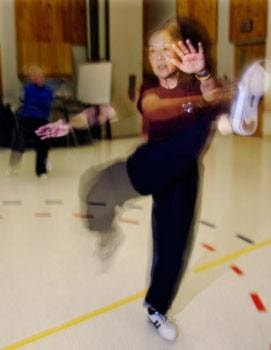Since we are unable to grow an extra layer of fur, it is safe to say that none of us would want to live outside in the winter and endure the frigid elements of our northern climate.
But the 10 species of northern mammals at the Yukon Wildlife Preserve don’t seem to mind much at all.
That being the case, it only makes sense that the Wildlife Preserve remains open to the public througout the winter.
“We’re open throughout the year — in the winter we have less visitors, but enough to make it worth it to keep it open,” said the preserve’s program director Clare Estelle Daitch. “We do it by appointment because there’s only one interpreter on staff.”
Visitors can tour the five kilometres of preserve trail on a tour bus, on foot, on snowshoe or even cross-country skies.
“We don’t have the trails set, but as you can see there’s plenty of room to ski,” said Daitch.
The property was first acquired in the 1960s by a man called Danny Nowlan with the intention of creating a preserve.
“He and his wife built this place,” said Daitch. “They ran it mainly to breed captive wildlife to sell to zoos all over the world. If you go and find muskoxen at the zoo, they’re probably related to our muskoxen.”
With few prospective buyers of the land, the Yukon government bought it in 2000.
Since then the preserve is run by a non-profit society.
The preserve has roughly 306 hectares of land that contains a variety of geographic features to better accommodate the variety of animals, which include elk, thinhorn sheep, mule deer, Alaska Yukon moose, mountain goats, woodland caribou, muskoxen, lynx, ground squirrels and North America’s largest land mammal, the wood bison.
“Bison were indigenous to the Yukon historically, they went extinct about 100 years ago in the Yukon,” explained Daitch. “This herd was reintroduced from Elk Island National Park, which is where the rest of the buffalo in the Yukon came from.
“They’re a little shaggier, darker and taller than their plains cousins.”
The elk share a similar story with the bison.
Disappearing from the territory about 1,500 years ago, the elk were also reintroduced fairly recently, in the 1950s and ‘90s — also coming from Elk Island.
“The bison have done really well — they don’t have any natural predators in the Yukon.”
The lynx are currently held in a small enclosure that is fenced in on the top. However, about $25,000 of approximately $50,000 for a new enclosure has been raised, which the preserve hopes to have open in the spring.
“It’s going to be a bit bigger and it’s going to have what’s called invisible fencing, which isn’t invisible but from far away you won’t see the fence,” said Daitch. “It’s increasingly popular with zoological preserves and stuff — it’s very expensive.
“It’s illegal in the Yukon to have captive wildlife, except for us because we’re regulated by the Department Of The Environment. When the laws changed the lynx came in — they were owned by someone.
“So they came to us and they were too old and too used to being in captivity to be released into the wild.”
Also on the grounds is a bird rehabilitation centre. Although usually empty in the winter, it often holds such birds as eagles and owls as well as ducklings and robins in the warmer seasons.
“We get injured animals, but mainly we get injured birds,” said Daitch. “Our veterinarian rehabilitates them and releases them back into the wild.
“I think about 30 came through this summer … most of them were able to be released.”
Daitch recently moved to the Yukon from Yellowknife and has replaced Rebecca Bradford-Andrew as manager.
Although new to the role, she is so full of knowledge of the animals it’s hard to imagine her not being there for years.
“All males in the deer family have antlers,” said Daitch. “Of the deer family, only the female caribou have antlers, which is a bit of an interesting adaptation…
“The theory goes that a long time ago all of the mountain sheep were stone-sheep coloured,” said Daitch, turning her attention to the snow white bundles of wool that line a cliff face. “Then through adaptation to the northern climate some of them have become white, or Dall-sheep coloured, to blend in with the snow. It’s hard to know if that’s true or not, but it’s one theory.
“They have really long hoofs, which is great for scrambling up mountains. They are very well adapted to that kind of environment.”
More information on the preserve and its animals can be found at www.yukonwildlife.ca and tours can be arranged by calling 633-2922.
Contact Tom Patrick at
tomp@yukon-news.com
